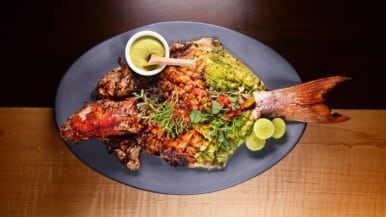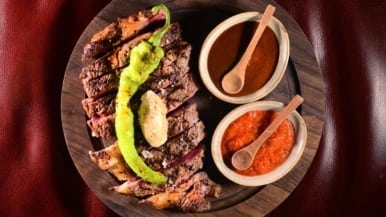Why tipping is going away (and why I’ll miss it)
Now that more Toronto restaurateurs are doing away with gratuities, how will diners reward the good servers—and punish the bad?

Never bleed in the borscht. That was the big lesson from my short career as a server. I was a student (an eternity ago), and a roommate’s sister’s friend got me a job at Future Bakery in the Annex. I knew the place well; I’d nursed plates of mashed potatoes, the cheapest thing on the menu, while cramming for exams there. The manager was disappointed I didn’t know Polish or Ukrainian, but satisfied when I fit into my uniform, a company T-shirt left by the last guy. As the newbie, I was given the sections where the sullen and the drunk seemed to congregate. Old ladies would yell at me when I delivered bowls of borscht with insufficient sour cream. I quickly learned not to expect much in the way of tips.
At the end of my second week, another server, an intimidating woman with a scar across her forehead, grabbed me by the T-shirt as I returned to the kitchen from running more borscht. She pointed to my left hand. I looked down and saw red. Borscht? No. Blood. I’d cut myself and, exhausted from too many early-morning shifts in a row, hadn’t noticed. Tables complained. And I was promptly sent to Toronto Western for stitches. While waiting for a doctor, I either fainted or nodded off, and fell from my chair to the floor. By the time I was released, my shift was over. I never returned.
Which is to say I have an appreciation for the plight of restaurant staff. The great servers, those who enhance the experience of dining, really stand out. Among my favourites are the bow-tie-and-vest guys at Barberian’s, some of whom have been there for decades and deliver a steaming baked potato like it’s a Fabergé egg. Or the telepathic staff at Scaramouche, who recall exactly which table at the window you prefer, even if you only dine there once in a while. Great servers genuinely love the food they’re serving, like one I recently had at Local Kitchen and Wine Bar, in deepest Parkdale, who in a few words convinced me I would be transported by a tartare of Gaspé lamb that fed on nutrient-rich seaweed (she was right—the earth moved). From the moment Momofuku Noodle Bar opened, I was convinced one of the servers had a crush on me. She’d wave a welcome from across the room and seemed to genuinely want to know how I was doing. Months would pass between visits and yet she’d remember my regular order (smoked chicken ramen, pork bao, fizzy water). Then, during one recent lunch, I noticed her having the same intently friendly conversation with a suited businessman a few seats over. She even asked after his kids. It was hard not to admire her skill—even as I realized that to her I was just another guy with a high-ramen diet.
Great servers are the exceptions. Now that fine dining occurs on picnic tables in former garages, and waiters wear jeans and sneakers, good service has become as elusive as a TTC seat free of mysterious stains. I’ve begun classifying servers according to their sins. There are the slothful servers who use canned patter and who disrespect the airspace above the table, reaching across, mere millimetres from your face, to adjust flatware and refill a glass. There are the greedy servers who ignore you to fawn over a group of blatant big spenders, and the wrathful servers who give you the bum’s rush, snatching away your glass with a full gulp of wine still in it, when you’re not in the mood for a dessert course. The newest breed of offender is the prideful server who rattles off lists of foraged, esoteric ingredients and rolls his or her eyes when you innocently ask if capsicum is a pepper or a mushroom. (A related breed is the condescending server, like the one I recently encountered at Jamie’s Italian who apparently believes anyone eating at the Yorkdale mall hails from that X-Files hillbilly farm, and instructed our table, unprompted, on the definitions of passata, bucatini and salumi.)
The trick with service is to ensure it’s attentive without slinking into servility. Restaurant groups like Oliver and Bonacini (which runs Bannock, Auberge du Pommier, O&B Canteen, and others) and King Street Food Company (the three Bucas, the Saint, Jamie’s Italian) have handbooks for staff that choreograph how you’ll experience their restaurants from the moment you walk through the door. The hierarchy of the wait staff is strictly enforced, which can sometimes become obnoxious, like how the person who refills your water at Yorkville’s Kasa Moto, operated by the Chase Group, won’t take your request for a second cocktail and instead fetches the server proper. The strangest display of hierarchy I’ve witnessed is at O&B’s Canoe, high up in the TD Centre, where the thinner air seems to elevate the tension among staff. On two occasions I’ve witnessed my server dart across the room to haughtily interject when one of the server assistants (a.k.a. bussers) delivers a course and attempts to explain what’s on the plate. You’d think they were auditioning for Downton Abbey.
This is a pivotal moment for the service industry: taxi drivers are battling the Uber army, anyone with a spare room can run a hotel, and a Facebook comment about the smallest server hiccup can irreparably damage a restaurant’s fragile reputation. (Thankfully Twitter hadn’t yet been invented when I bled all over my customers at Future Bakery.) Now, adding to the service-industry upheaval, a dozen-plus prominent restaurants in the U.S., mostly concentrated in New York, have instituted no-tipping policies, which almost always means the gratuity is built into the bill as an automatic charge (same as when you pay for an Uber ride). Usually it’s around 12 to 15 per cent. As of this writing, only a few Toronto restaurants, including Sidecar (and its sister drinking club, the Toronto Temperance Society) and Indian Street Food Company, have announced such a policy, though I predict that it’s the beginning of the end of tipping as we know it.
If you just emitted a skeptical harrumph, I hear you. Deciding how much of a tip a server deserves is a particular pleasure of dining out—it’s a reward for good service, or a way to express displeasure for food served cold, a tradition as old as restaurant-going itself. Without tipping, what will motivate the server?
The main argument for killing tipping is that it’s unfair. Restaurant owners adopting no-tipping policies in New York say that gratuities create an imbalance, with servers able to earn hundreds of dollars a night—especially in the fancier establishments where a typical two-person meal might cost $500 and up—while line cooks and support staff earn low to minimum wages. If they’re lucky, they’ll get a small cut of the server’s tip pool. At Dirt Candy, a famous vegetable-focused New York restaurant, chef Amanda Cohen argues that tipping is a social justice issue. She abolished it and instituted a 20 per cent administration fee—so she could pay all her employees a living wage. (She’s Canadian, which may have influenced her concerns for a worker safety net.) There’s self-interest on the part of these restaurateurs at work, since by redistributing among their staff what money might otherwise have gone solely to servers, they’re able to better retain staff who’d otherwise be priced out of an expensive city. And it’s good PR, too. The restaurateur Danny Meyer (the most prominent American proponent of no-tipping) reported that December, the first full month with his “Hospitality Included” model in effect at the Modern at MoMA, was the restaurant’s most profitable month ever.
The cost of living here isn’t as high as it is in Manhattan, though there’s still a case to be made that restaurant workers should be more equitably compensated. Indian Street Food Company at Bayview and Eglinton is owned by Hemant Bhagwani, the chef behind the Amaya mini-chain. The average income in its uptown neighbourhood is among the city’s highest, and tipping is a reflex. When Bhagwani opened his place last November, replacing a branch of Amaya, he announced that in lieu of tips, his bills would include a 12 per cent “administration fee,” a tip by another name, which he’d mete out evenly to all staff. One wall of the restaurant’s vestibule is painted with a mural of an elephant (wearing sunglasses over its eyes and chili peppers over its tusks), and the words No Tipping Please. The words also appear in block letters at the bottom of the cheque. On my last visit, the Friday of the Family Day weekend, every seat was taken, including the ones at the bar facing the kitchen, and there was a line to get in. It’s fair to say the neighbourhood has gotten the hang of No Tipping Please. As for the service, it wasn’t any different from any of the busier spots in Gerrard’s Little India, which is to say there was general, amiable chaos.
My dinner date and I were lucky to get seats at the bar, where we had an excellent rendition of north Indian chaat; blistered, buttery naan; mustard chicken; and whiskey sours laced with a trendy rosehip shrub. From behind a curtain, there were glimpses of a happily busy kitchen. I didn’t notice any tables complaining that they didn’t get enough sour cream or any servers running around with blood gushing from their hands. We had some four or five staff ask us how we were enjoying our dinner, including the bartender. One young server told us he’d arrived from Punjab two months ago. Indian Street Food Company is his first job in Canada. How’s he doing? He gave a wide smile—he’s loving it.










